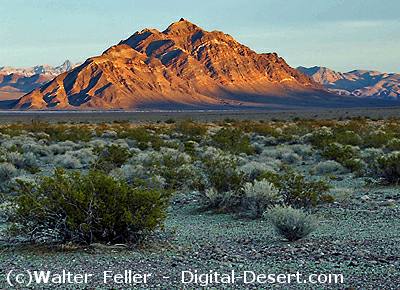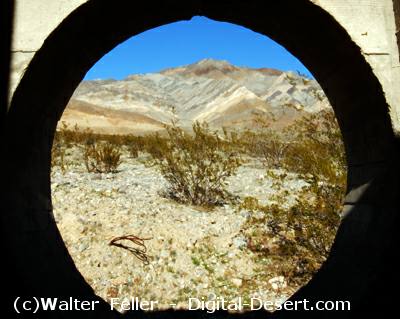Subsection 322Ac
Amargosa Desert - Pahrump Valley
This subsection includes the alluvial plains of the Amargosa Desert, Sarcobatus Flat, Stewart Valley, Pahrump Valley, Mesquite Valley, and California Valley. There are a few moderately steep hills protruding through the alluvial plain. It has a hot and arid climate. MLRA 30g.
Lithology and Stratigraphy. This subsection contains mainly Quaternary fluvial, lacustrine, and eolian sand deposits. Hills protruding through the alluvial plain are mostly Cambrian marine sedimentary rocks.
Geomorphology. This subsection is mainly on very gently to moderately sloping alluvial fans, nearly level basin floor and dry lake bed. The Amargosa Desert, and Stewart, Pahrump, and Mesquite Valleys are in a northwest to southeast line. California Valley is oriented toward the north-northeast. Alluvial fans slope up to about 18%, but only the upper parts of them have slopes > 12 or 15%. There are large playas on the lake beds. The elevation range is from about 2280 feet in California Valley to about 5000 feet at the base of the Bullfrog Hills between the Amargosa Desert and Sarcobatus flat. Fluvial erosion and deposition and eolian deflation and deposition are the main geomorphic processes.
Soils. The soils are mostly Typic Torripsamments and Typic Torriorthents on younger fans and Typic Calciorthids and Typic Haplargids on older fans. They are Typic Torrifluvents, Typic Torri-psamments, Typic Torriorthents, Typic Calciorthids, and shallow Typic Paleorthids on basin floor. Soils on hills are mostly Lithic Torriorthents. The soils are well drained, except on poorly drained playas. The soil temperature regimes are thermic. Soil moisture regimes are aridic.
Vegetation. The predominant natural plant community is Creosote bush series. Joshua tree series occurs on alluvial plains. Mixed saltbush series is common on basin floors and Iodine bush series and Saltgrass series are present on wet basin-fill and lacustrine deposits. Greasewood series occurs in riparian areas and around saltmarsh.
- Characteristic series by lifeform include:
Grasslands: Alkali sacaton series, Desert sand - verbena series, Indian ricegrass series, Pickleweed series, Saltgrass series.
Shrublands: Brittlebrush series, Creosote bush series, Creosote bush - white bursage series, Desert-holly, Fourwing saltbrush series, Greasewood series, Iodine bush series, Mixed saltbush series, Scadscale series, White bursage series.
Forests and woodlands: Mesquite series.
Surface Water. Runoff is rapid from mountains and alluvial fans and slow from basin-fill. The drainage is either internal, to sinks within the subsection, or to the Amargosa River which drains to Death Valley. California Valley drains to Silurian Valley. Streams are dry most of each year. There is temporary ponding on playas, or dry lake beds.
< previous - Mojave Desert - next >
clickable map - select a section to view
Ash Meadows
-
Warm water from underground bubbles up through sand into clear spring pools. Silvery blue pupfish dart between ...
Amargosa River
-
The Amargosa River originates in the mountains surrounding Beatty, Nevada, flows through the Amargosa Desert region, ...
Amargosa Desert
Miscellaneous Geology:Devil's Hole

Amargosa Desert

Amargosa Desert